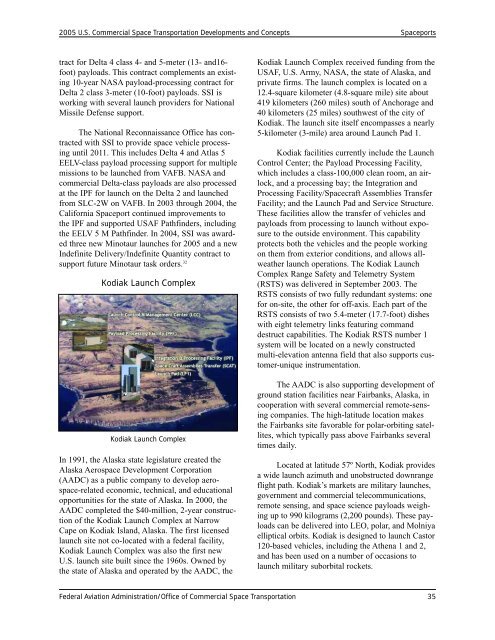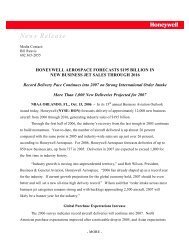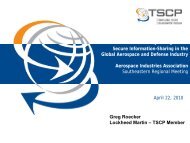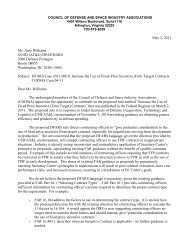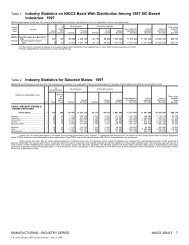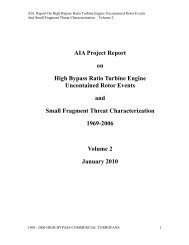Untitled - Aerospace Industries Association
Untitled - Aerospace Industries Association
Untitled - Aerospace Industries Association
Create successful ePaper yourself
Turn your PDF publications into a flip-book with our unique Google optimized e-Paper software.
2005 U.S. Commercial Space Transportation Developments and Concepts Spaceportstract for Delta 4 class 4- and 5-meter (13- and16-foot) payloads. This contract complements an existing10-year NASA payload-processing contract forDelta 2 class 3-meter (10-foot) payloads. SSI isworking with several launch providers for NationalMissile Defense support.The National Reconnaissance Office has contractedwith SSI to provide space vehicle processinguntil 2011. This includes Delta 4 and Atlas 5EELV-class payload processing support for multiplemissions to be launched from VAFB. NASA andcommercial Delta-class payloads are also processedat the IPF for launch on the Delta 2 and launchedfrom SLC-2W on VAFB. In 2003 through 2004, theCalifornia Spaceport continued improvements tothe IPF and supported USAF Pathfinders, includingthe EELV 5 M Pathfinder. In 2004, SSI was awardedthree new Minotaur launches for 2005 and a newIndefinite Delivery/Indefinite Quantity contract tosupport future Minotaur task orders. 32Kodiak Launch ComplexKodiak Launch ComplexIn 1991, the Alaska state legislature created theAlaska <strong>Aerospace</strong> Development Corporation(AADC) as a public company to develop aerospace-relatedeconomic, technical, and educationalopportunities for the state of Alaska. In 2000, theAADC completed the $40-million, 2-year constructionof the Kodiak Launch Complex at NarrowCape on Kodiak Island, Alaska. The first licensedlaunch site not co-located with a federal facility,Kodiak Launch Complex was also the first newU.S. launch site built since the 1960s. Owned bythe state of Alaska and operated by the AADC, theKodiak Launch Complex received funding from theUSAF, U.S. Army, NASA, the state of Alaska, andprivate firms. The launch complex is located on a12.4-square kilometer (4.8-square mile) site about419 kilometers (260 miles) south of Anchorage and40 kilometers (25 miles) southwest of the city ofKodiak. The launch site itself encompasses a nearly5-kilometer (3-mile) area around Launch Pad 1.Kodiak facilities currently include the LaunchControl Center; the Payload Processing Facility,which includes a class-100,000 clean room, an airlock,and a processing bay; the Integration andProcessing Facility/Spacecraft Assemblies TransferFacility; and the Launch Pad and Service Structure.These facilities allow the transfer of vehicles andpayloads from processing to launch without exposureto the outside environment. This capabilityprotects both the vehicles and the people workingon them from exterior conditions, and allows allweatherlaunch operations. The Kodiak LaunchComplex Range Safety and Telemetry System(RSTS) was delivered in September 2003. TheRSTS consists of two fully redundant systems: onefor on-site, the other for off-axis. Each part of theRSTS consists of two 5.4-meter (17.7-foot) disheswith eight telemetry links featuring commanddestruct capabilities. The Kodiak RSTS number 1system will be located on a newly constructedmulti-elevation antenna field that also supports customer-uniqueinstrumentation.The AADC is also supporting development ofground station facilities near Fairbanks, Alaska, incooperation with several commercial remote-sensingcompanies. The high-latitude location makesthe Fairbanks site favorable for polar-orbiting satellites,which typically pass above Fairbanks severaltimes daily.Located at latitude 57º North, Kodiak providesa wide launch azimuth and unobstructed downrangeflight path. Kodiak’s markets are military launches,government and commercial telecommunications,remote sensing, and space science payloads weighingup to 990 kilograms (2,200 pounds). These payloadscan be delivered into LEO, polar, and Molniyaelliptical orbits. Kodiak is designed to launch Castor120-based vehicles, including the Athena 1 and 2,and has been used on a number of occasions tolaunch military suborbital rockets.Federal Aviation Administration/Office of Commercial Space Transportation 35


